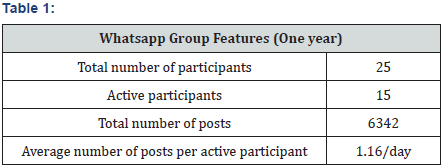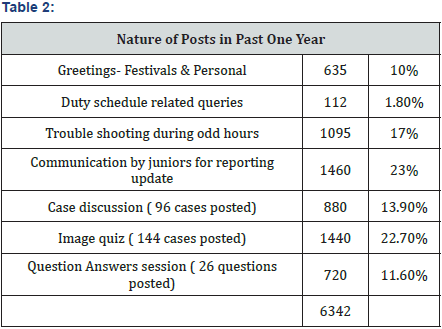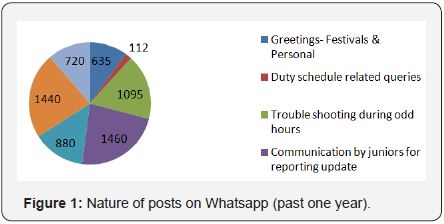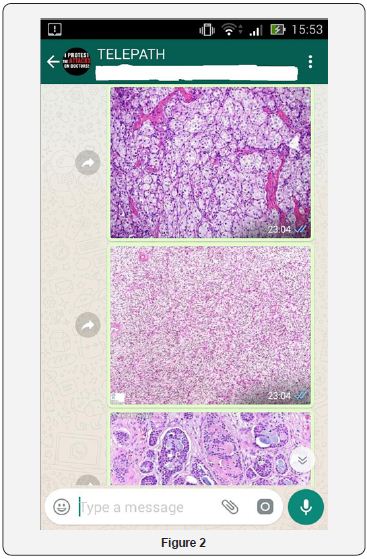Juniper Publishers- Open Access Journal of Case Studies
Interactive Whatsapp Teaching in Pathology
Authored by Rateesh Sareen*
Introduction
Over the past number of years, the term “21st Century Learning” has become synonymous with educational change and promising pedagogical transformation. 21st century marks the abundance of social media platforms like twitter, face book and Whatsapp [1]. Social media implies any medium of two way communication. Web 2.0 is the term given to describe a second generation of the World Wide Web that is focused on the ability for people to collaborate and share information online. Web 2.0 basically refers to the transition from static HTML Web pages to a more dynamic Web that is more organized and is based on serving Web applications to users.
The technological edge that is present today has markedly improved the communication and interaction among our peers. Pathologists all over the world can share rare cases and educate peers with magnificent images. There are numerous pros and cons related to Whatsapp use in teaching and communication between pathologists, residents and even technicians [2]. Social media like Whatsapp should be used as adjunct to blackboard classroom teaching and one needs to be aware of its shortcomings.
If we go by the advantages of Whatsapp use in pathology teaching it begins with the sharing of quality images using smart phones which maintain subtle morphological details of the case accurately [3]. The participants at will can choose their time for participation in discussions. There are less time constraints to discussions as many times they can last for a day or two. The ease and flexibility in participation makes it highly acceptable to students [4].
The major drawbacks are the lack of ‘peer review’, of the cases and opinions and articles posted on social media. Therefore it is necessary that a senior pathologist in the form of facilitator should be included in group so that fruitful academic discussions take place in the group and participants refrain from futile departmental gossips [5]. The other pitfall is the addictive nature of such social media that interfere with daily activities of participants including departmental work and many times personal life of individuals.
Material and Methods
The study was conducted in the department of Pathology and transfusion medicine Santokba Durlabhji Memorial Hospital & Research center, Jaipur. A Whatsapp group was created in July 2015 with the author of this study being the group, administrator by the name ‘Telepathology’. All doctors in the department including consultants (10), senior residents (3), and DNB residents (12) were the members of the group (Table 1). Out of 25 participants, 15 were active. A total of 6342 posts were posted from July 2016 till July 2017.

The group was created initially to facilitate the communication between consultants and residents and for formal communication pertaining to duty schedule, pending tasks, support during odd hours, online consultation with senior fellows in department and reminders for classes. The group received warm welcome by all participants and once all became familiar with its use other academic activities like case discussions, interesting cases and image quiz were introduced after a time gap of around 8 months after formulation of Whatsapp group. The new residents joining the department were made member of the group at the same time those who left the department were removed from the group. The cases were only posted by group administrator so that identity of patient and patient privacy could be maintained. All persons interested in posting cases, images seek approval from group administrator before posting the posts on group.
Results
After nearly two years of the functioning of group we collected data, posts from the group and did a retrospective study of past one year, from July 2016 till July 2017 to for evaluating the usefulness of the use of Whatsapp use in the department. We did not included initial one year of Whatsapp group creation in our study as it was the time where our group members were getting acclimatized and familiar with social media usage. The nature of posts included greetings, routine duty roaster including changes if any, trouble shooting, communication by juniors of task completion and academics. 48.2% of the posts were related to academic activities, 41.8% were related to daily work like duties, trouble shooting & day to day communication/ information. The remaining 10% were greetings which had no value for department. Regular advisory was given to keep Whatsapp group free of such posts but it took us in a year to bring it as low as 10% (Table 2).


A total of 96 cases (twice weekly), 144 image quiz (thrice weekly) and 26 questions (multiple responses or one liner) were posted in a year. (Table 2) The image quiz received higher number of posts than cases 1440 verse 880. Overall, 90% posts were either academic or related to department resulting in facilitated communication among pathologists (Figure 1 & 2).
As such there are no laws to regulate case sharing on social media. The increased use of such technologies will eventually call for ethical compliance and maintenance of patient privacy so that professional and societal benefits could be reaped. One of the prime concerns is the inadvertent identification of the patient. This could be avoided by following strategies:

- Non disclosure of date and time of the case in question, any unusual special circumstances, ethnicity, specific age, facial images, identifying features of patients without his/her permission. Although the posts can be deleted but it still does not guarantee full privacy as the image could have been downloaded by other users [6]. The dictum holds true that once image has been released, it is public forever.
- Alteration of patient’s fine details like rounding off age to nearest decade, modification of anatomical site, clinical history at the same time retaining relevance of clinical history and maintaining patient confidentiality.
- Presence of senior facilitator in the group so that discussions remains academic and at the same time provides a peer review of the case on forum.
- Appropriate time of posting cases to cause minimal loss of time and interference with daily work schedule.
- Slow pace of discussions so that maximum participants can join the discussion.
- Minimal criticism for silly mistakes so that participants are not weary of comments and can express them in full capacity.
- Never post anything when angry.
- Strive for accuracy-Although the communication of Whatsapp is intended to be informal it does not mean that one posts lazy words as people will read what you have written.
- Ask permission from patient in case you want to write about specific details pertaining to patient.
- Be respectful-Do not say anything to a person which you can’t say in person.
- Assume beneficence-Most of us aim to do things what are right. People fancy that doctors protect doctors; social media tempts to toss stones but resist the urge.
- Educate yourself and ask questions with an unbiased mind.
The use of social media by pathologist results in increased interaction between physicians-pathologists, students and patients. As barriers to discussion are minimal one must ensure patient privacy so that professional and societal benefits out weight any potential harm to patient privacy.
For more articles in Open Access Journal of Case Studies please click on: https://juniperpublishers.com/jojcs/index.php



No comments:
Post a Comment